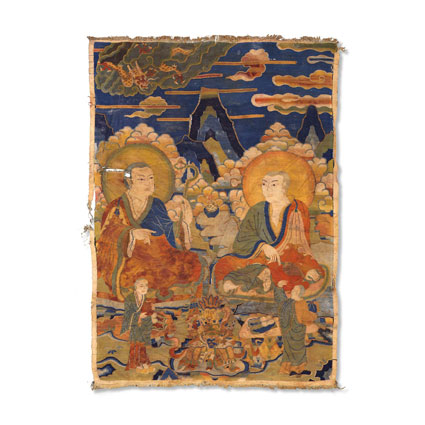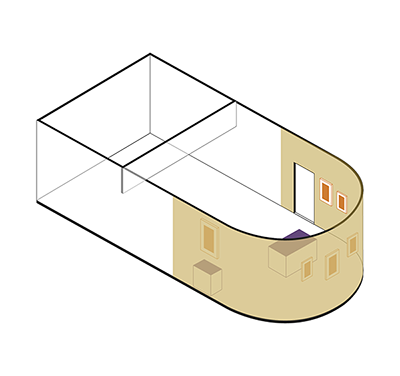ABP 018
Code: ABP 018
Country: Tibet
Style:
Date: 1300 - 1400
Dimensions in cm WxHxD: 42.5 x 60
Materials: Kesi textile
Two unidentified Arhats
This silk tapestry—kesi in Chinese—represents two figures seated in a mountainous landscape. Dressed in heavy monastic robes, heads shaved, they respectively hold a ruyi scepter and a fly whisk. Generally belonging to a group of sixteen, these two masters represent the arhat or sthavira (elders), the first disciples of the Buddha.
This piece most likely belonged to a set of nine tapestries with a depiction of the Buddha Shakyamuni in the center. Their cult and depiction originated in China, which explains the strong Chinese influence in their outfits and the general aesthetic, with hemmed clouds, steep mountains, and a dragon in the sky. At their feet stand two similar looking but smaller servants and in the middle sits Vaishravana, the armored guardian king of the North. Despite the strong Chinese influence, this work appears adapted to Tibetan taste, especially in the physical appearance of the two main figures. The use of silk gives the colors brilliance and depth.
This silk tapestry—kesi in Chinese—represents two figures seated in a mountainous landscape. Dressed in heavy monastic robes, heads shaved, they respectively hold a ruyi scepter and a fly whisk. Generally belonging to a group of sixteen, these two masters represent the arhat or sthavira (elders), the first disciples of the Buddha.
This piece most likely belonged to a set of nine tapestries with a depiction of the Buddha Shakyamuni in the center. Their cult and depiction originated in China, which explains the strong Chinese influence in their outfits and the general aesthetic, with hemmed clouds, steep mountains, and a dragon in the sky. At their feet stand two similar looking but smaller servants and in the middle sits Vaishravana, the armored guardian king of the North. Despite the strong Chinese influence, this work appears adapted to Tibetan taste, especially in the physical appearance of the two main figures. The use of silk gives the colors brilliance and depth.


